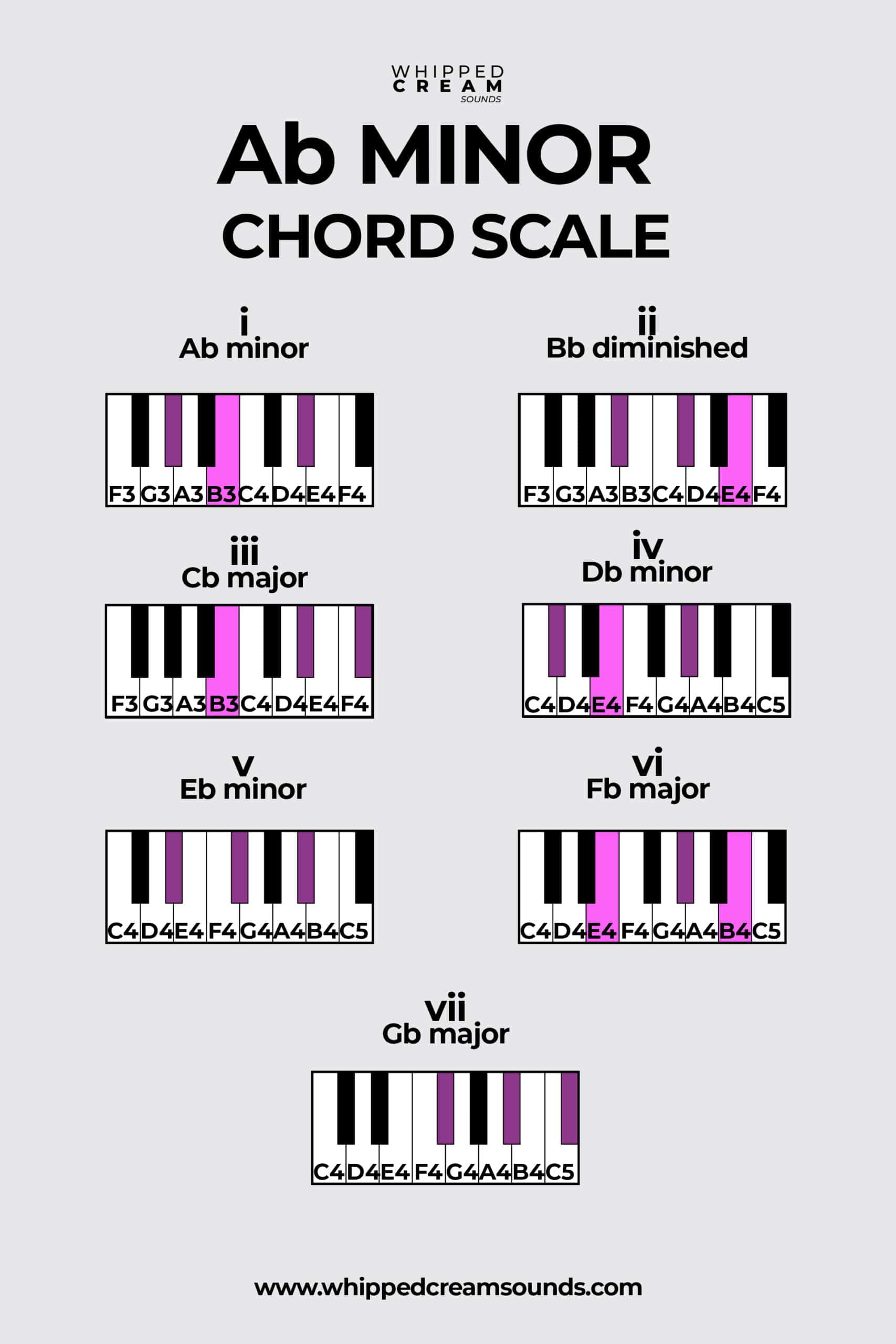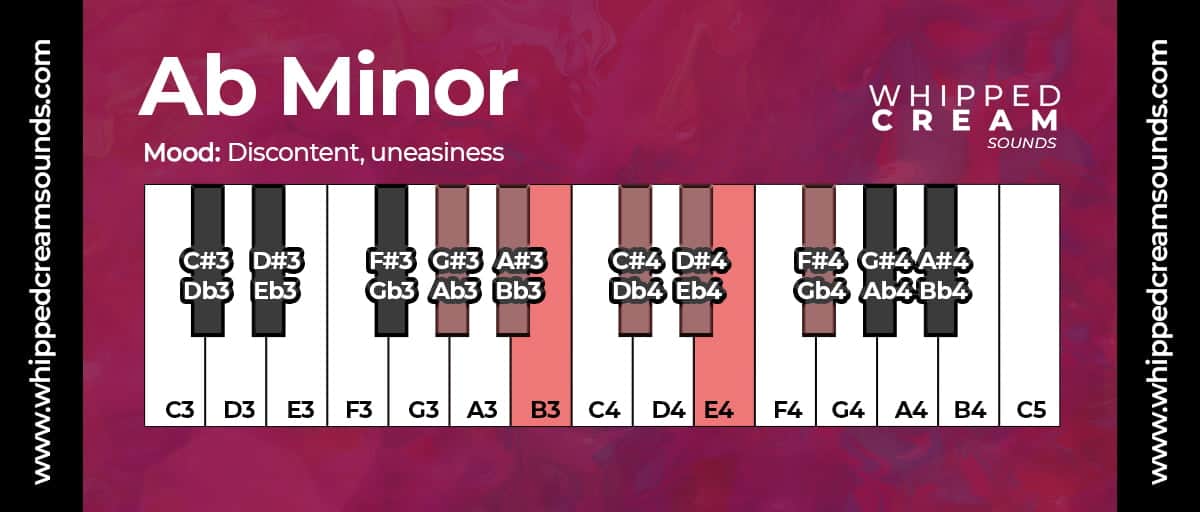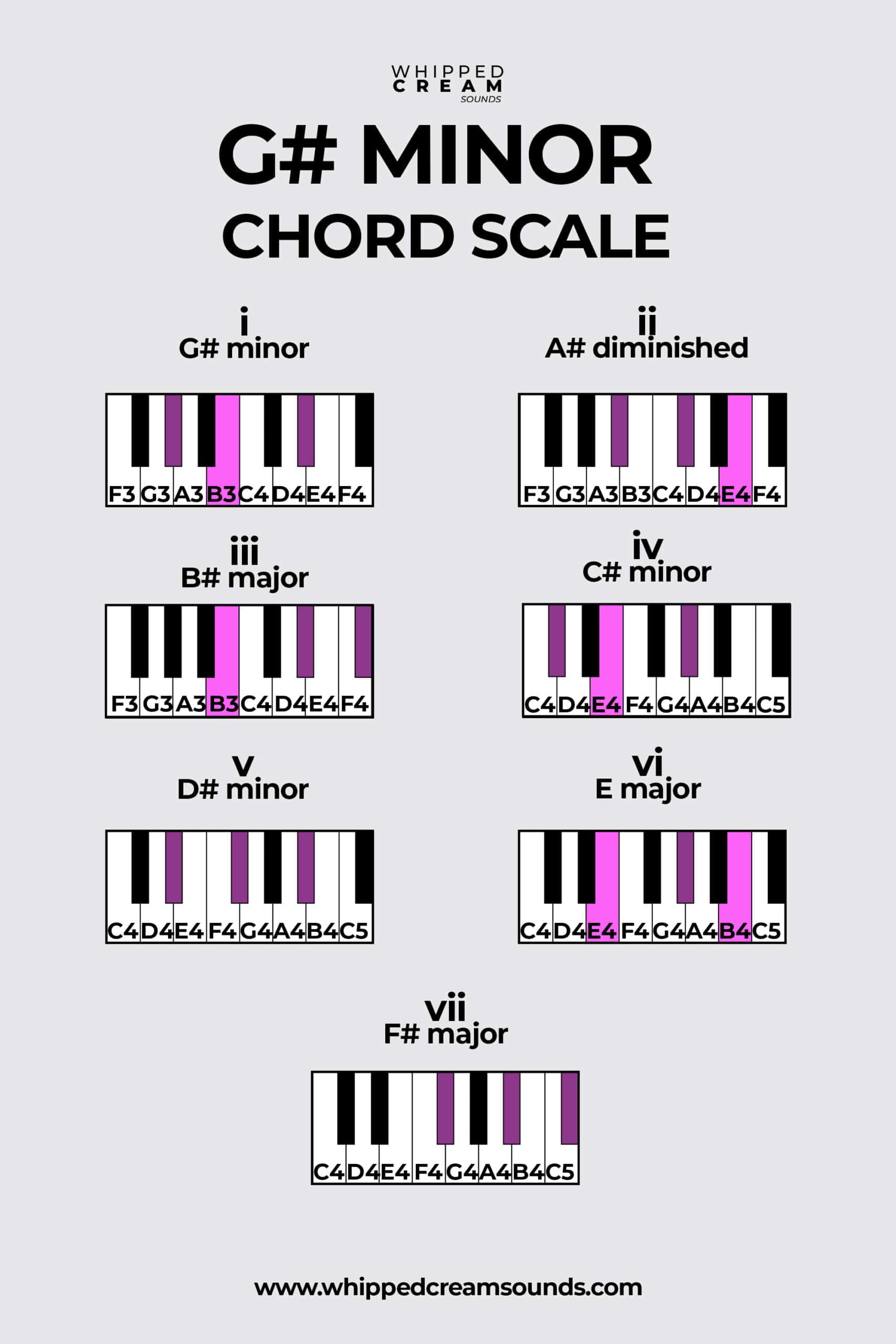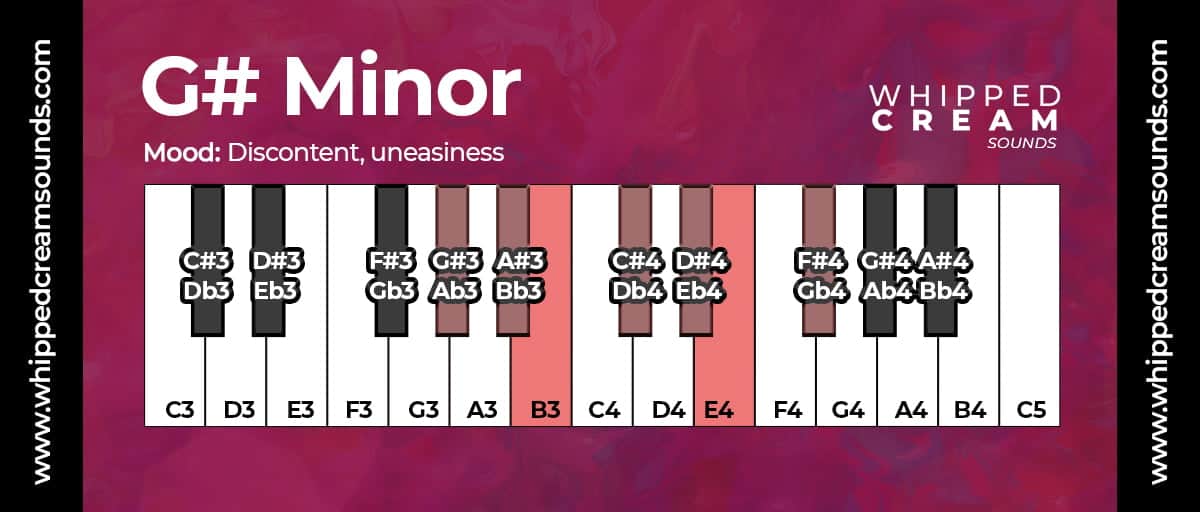The Ab minor chord scale is a sequence of chords that reside in the key of A flat minor. You can use chord scales to create melodies that sound good together and in tune with each other. Think of them as a framework for creating chord progressions. Ab minor in particular is a great scale for creating emotions of discontent, unhappiness, and uneasiness. In this article, we’ll cover everything you need to know about the A flat minor chord scale, what it uses are and why it’s important to know.
What Are The Chords in The Key of A Flat Minor?
To find out what chords are in the key of A flat minor, first you should find out which notes are in the A flat minor scale. You can then use formulas (which we’ll go over below) to work out everything else.
The A flat minor scale is as follows:
Ab, Bb, Cb, Db, Eb, Fb, Gb
When you have the notes in your desired scale (A flat minor), you’ll then want to work out the sequence the chords follow. To do this, you can use major & minor chord scale formulas. Simply plug them into the scale above.
The major & minor chord scale formulas are:
Major: major, minor, minor, major, major, minor, diminished
Minor: minor, diminished, major, minor, minor, major, major
Because you’re working in a minor key, you’ll want to use the minor formula to work out the chords. It’s much easier to just remember this sequence above, then you’ll be able to recall this whenever you want to find out the chords in any scale.
Using the minor formula, the A flat minor chord scale is as follows:
- Ab minor
- Bb diminished
- Cb major
- Db minor
- Eb minor
- Fb major
- Gb major
If you know how to play basic triads, you can now play the Ab minor chord scale. However, if you don’t know your chord shapes yet, you can use chord spellings to figure out each note of the chord.
The most common chord spellings are:
- Major – 1, 3, 5
- Minor – 1, b3, 5
- Diminished – 1, b3, b5
- Augmented – 1, 3, #5
Let’s do a quick example of the spellings above and how to use them. If you take a look at the 3rd chord in the Ab minor chord scale (Cb major), you can notice it’s a major chord. This means we must use the major chord spelling to work out the chord.
So, taking the Cb major scale (because Cb is the root note and the spellings are built to be used with the major scale), find the 1 note (Cb or B), find the 3 note (Eb or D#) and the 5 note (Gb or F#). This gives you your Cb major chord.
You can repeat this process for all the chords in the A flat minor chord scale. Remember to use the root note’s major scale to build the chord – even if it isn’t a major chord.
Which Notes Make Up The Chords of The A Flat Minor Scale
Once you know what the sequence of chords is, if you don’t know your basic triad shapes, then you need to know which notes make up each chord in order to play them.
Here are all the chords in the Ab minor chord scale, with each note mapped out:
- Ab minor – Ab, Cb, Eb
- Bb diminished – Bb, Db, Fb
- Cb major – Cb, Eb, Gb
- Db minor – Db, Fb, Ab
- Eb minor – Eb, Gb, Bb
- Fb major – Fb, Ab, Cb
- Gb major – Gb, Bb, Db
Common Chord Progressions in A Flat Minor
The great thing with chord scales is that you can use pre-made chord progressions that already sound good to kickstart your melody writing. These are a sequence of Roman numerals that signify which chord you should play. If you look closely, there are Roman numerals on the chord scale charts in this article.
These Roman numerals are the degree that the chord is at in the scale (between 1-7). When using a chord progression, you match the number with the correct number on the chart. This will give you your awesome progression!
Note: Anything with a 6, 7, 9 after it, is an extension chord, lowercase = minor, and uppercase = major.
Here are some common chord progressions in A flat minor:
- I–V–vi–IV
- V–vi–IV–I
- vi–IV–I–V
- IV–I–V–vi
The G Sharp Minor Chord Scale
The G sharp minor scale contains the same notes as the A flat minor scale (because they are the same note). However, the notation is written differently. Ab minor is more commonly used, because it is easier to write notes on musical score in Ab minor, than G# minor.
This will make it appear as if they’re entirely different musical scales, but they will sound exactly the same and, unless you’re writing musical scores, then it doesn’t matter which you use.
Nevertheless, we’ve mapped out the chords in the G sharp minor scale for you below as well and we’ll cover everything you need to know about the G sharp minor scale in the 2nd part of this article.
To find out the chords in the G sharp minor scale, it’s the same process as we explained above. You first need to understand which notes reside in the scale – then you can use formulas to help you work out the rest.
The notes in the G# minor scale are as follows:
G#, A#, B, C#, D#, E, F#
Once you have that, you can navigate to the formulas (listed above) to work out the chords in the key of G sharp minor. They’re essentially the same chords as the A flat minor chord scale, but will be written differently.
The Notes of Chords in The Key of G Sharp Minor
Just like in the A flat minor scale, it’s important to know which notes make up the chords in the G sharp minor scale.
- G# minor – G#, B, D#
- A# diminished – A#, C#, E
- B major – B, D#, F#
- C# minor – C#, E, G#
- D# minor – D#, F#, A#
- E major – E, G#, B
- F# major – F#, A#, C#
Common Chord Progressions in G Sharp Minor
The chord progressions listed above in A flat minor can also be used in G Sharp minor. If you want to create melodies, pre-made chord progressions are a great start.
Here are some different common chord progressions in G sharp minor:
- I – IV – V
- vi – ii – V7 – I
- IV – I6 – V
- I – iii – IV – V
- i – VI – i – v




